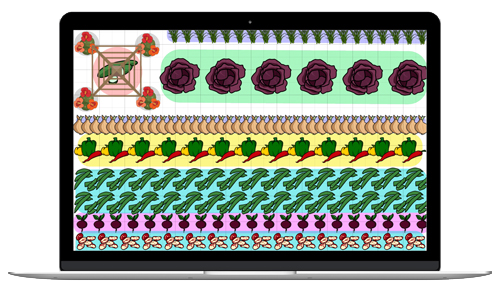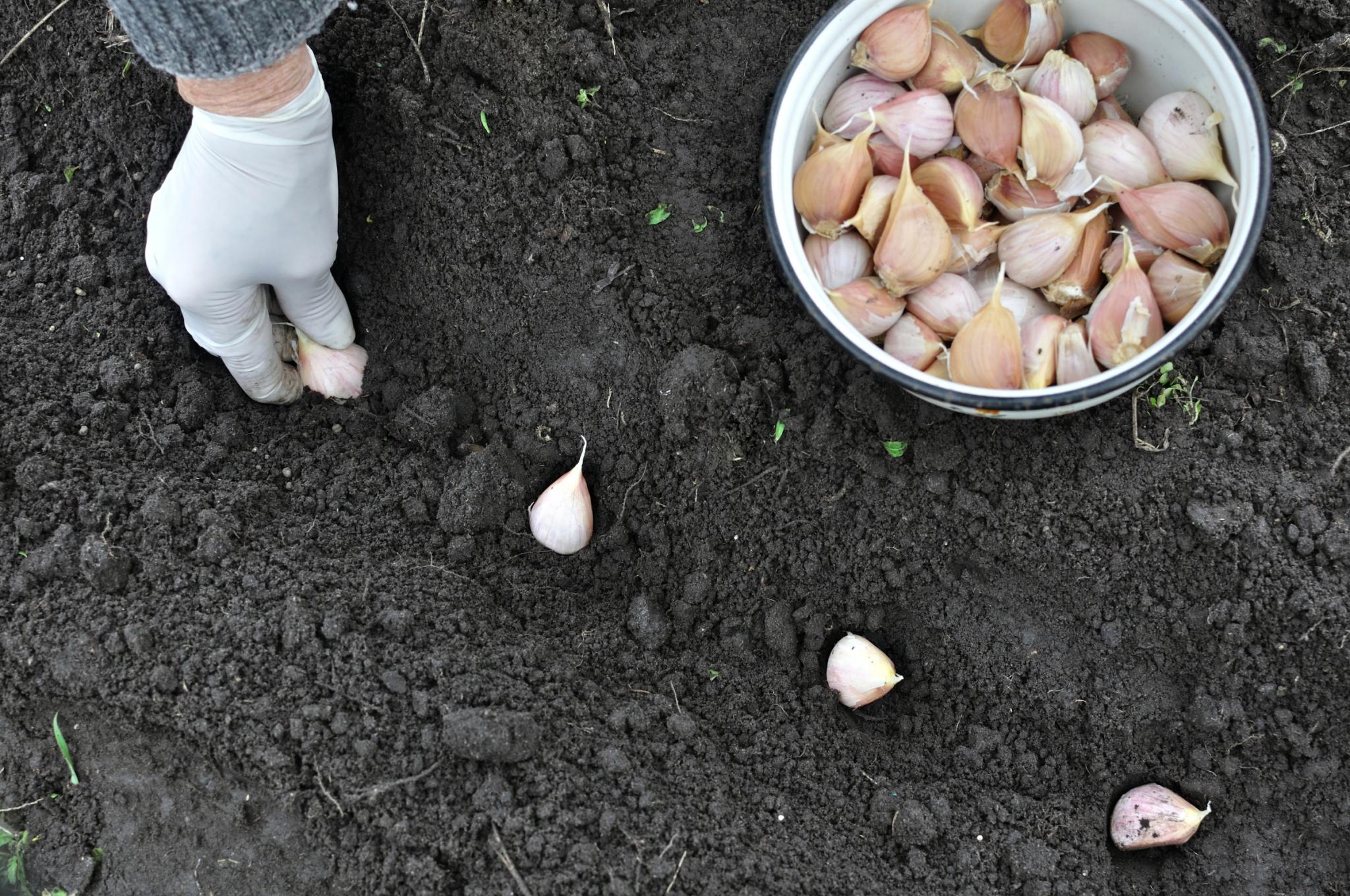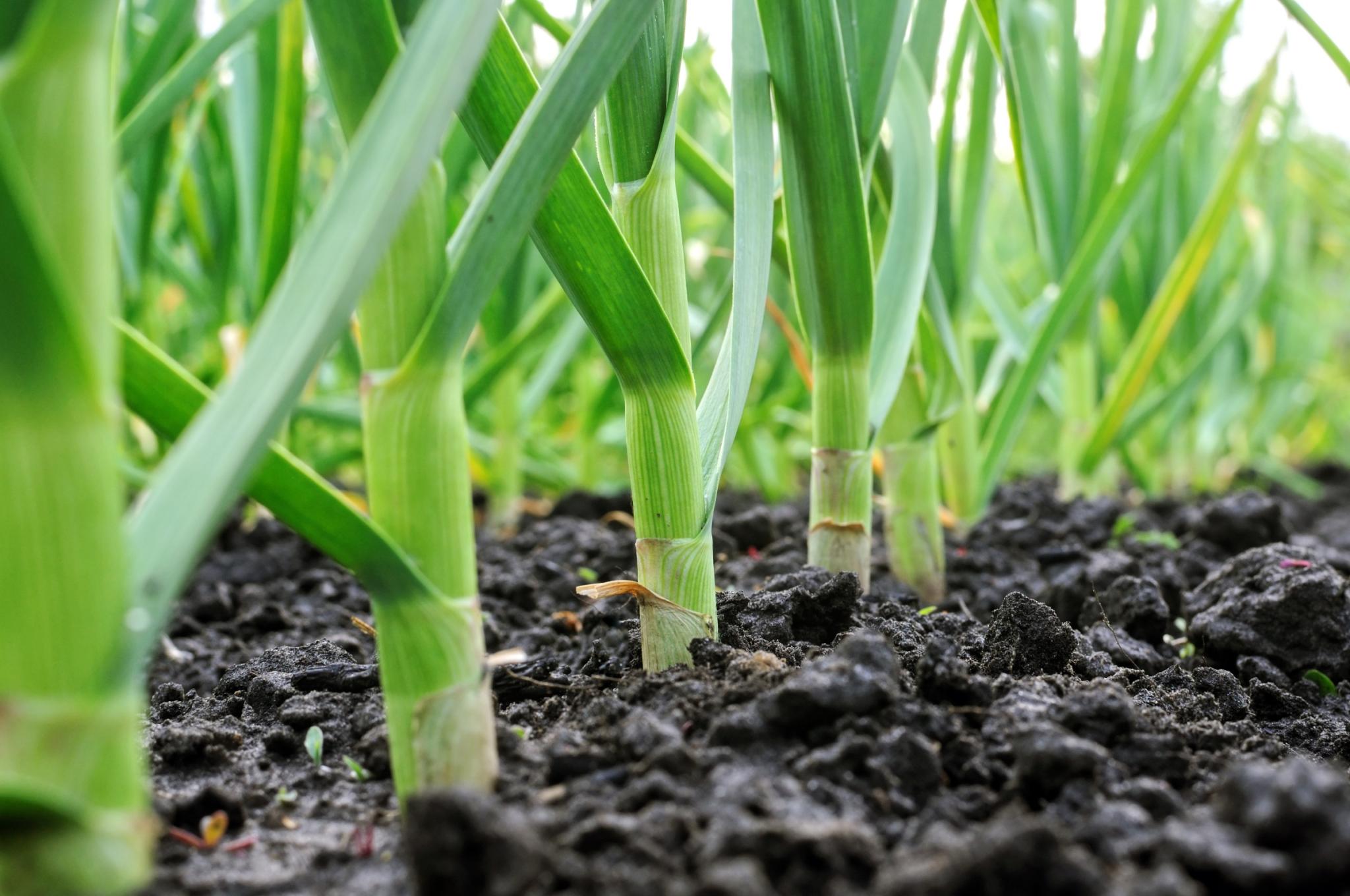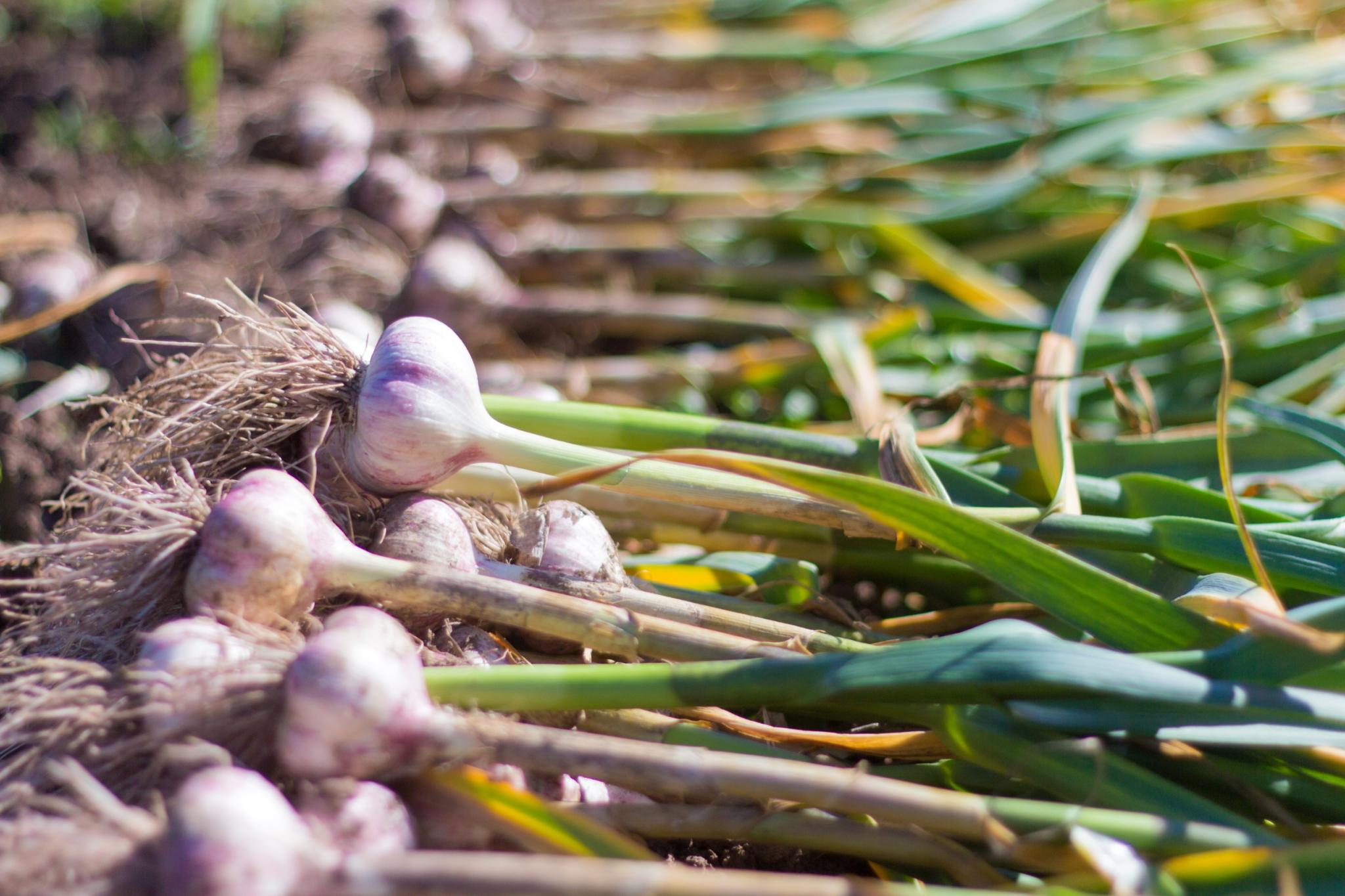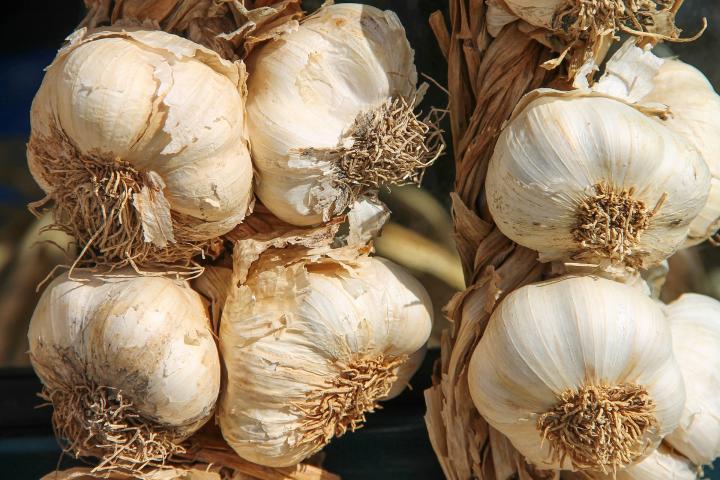
Easy garlic growing tips—from choosing varieties to planting cloves and harvesting tasty bulbs
The Almanac Garden Planner - Use It Free for 7 Days!
Plan your 2025 garden with our award-winning Garden Planner.
Types
Before you choose a variety of garlic, you need to consider your climate, which determines whether you plant a hardneck or softneck variety. Then you need to consider your cooking because different varieties have different taste profiles, from mild to sweet to bold to spicy!
Hardneck Garlic
Hardnecks are the best choice for Northern gardeners. This variety is extremely cold hardy for harsh winters. These grow one ring of fat cloves around a hard stem, with fewer but larger cloves per bulb than softnecks.
Bonus! Hardnecks produce flower stems, aka “scapes,” which must be cut to encourage the bulbs to reach their full potential. The scapes themselves are an early summer treat, delicious if chopped into salads or added to stir-fries.
Popular hardneck varieties: ‘Music’ (on the mild side yet rich and mellow); ‘Chesnok Red’ (mild and sweet, creamy texture when roasted); ‘Early Italian’ (sweeter flavor that won’t overpower dishes); ‘German Red’ (robust, classic garlic flavor which cooks love); ‘Spanish Roja’ (strong and hot, heirloom with classic garlic flavor).
Softneck Garlic
Softnecks are more common with Southern gardeners, growing well in warm climates with warm winters. They have more intense flavors and tend to grow bigger bulbs with smaller cloves per bulb because energy is not being diverted to top-set bulblets like hardnecks.
They do not have scapes, but they store better than hardnecks. Like their name suggests, they have necks that stay soft after harvest and, therefore, are the types that you see braided together.
Popular softneck varieties: ‘California White Early’ (classic moderate garlic flavor, most popular grocery store type, harvest in spring); ‘California White Late’ (harvest in summer); ‘Inchelium Red’ (wonderful but mild garlic flavor, superior storage life); ‘Silver White’ (classic garlic, great storage, excellent for beginner); ‘Lorz Italian’ (hot and zesty heirloom, popular with cooks).
Elephant Garlic
Elephant garlic isn’t a true garlic, but it is grown similarly to hardneck varieties, requiring a long, cool growing season in zones 3 through 9. Most types take about 90 days to harvest once growth starts. Despite its size, it has quite a mild flavor, more similar to onion and shallots than traditional garlic. Bulbs and cloves are large (up to one pound each!), with just a few cloves to a bulb.
See our complete video that demonstrates how to grow and harvest garlic!
Cooking Notes
- Learn how to make your own garlic powder to easily spice up a recipe.
- Roasted garlic bulbs are also a favorite of ours!
- Around the summer solstice (late June), hardneck garlic sends up a seed stalk or scape. Allow it to curl, then cut off the curl to allow the plant to put its energy into bulb formation. Use the scapes in cooking the same way you would garlic bulbs. We like to stir-fry scapes the way we cook green beans—similar, with a spicy kick! Note that they get more fibrous and less edible as they mature.
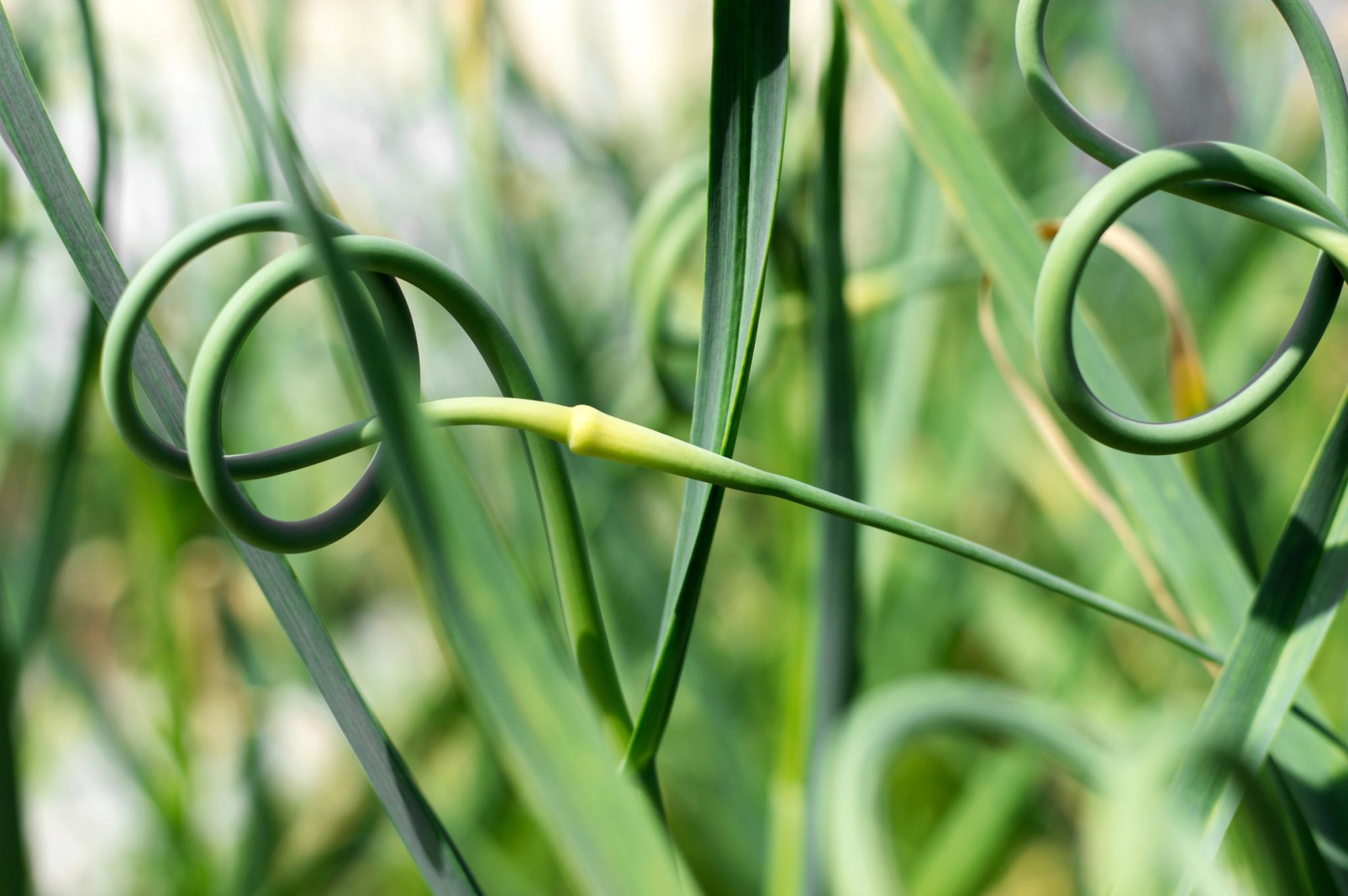
ADVERTISEMENT
But seriously. If you aren't sure if you have gotten them com then are still spreading you might just put in a bed for them so they can't spread any further. Since they are shallow rooted you wouldn't have to dig down too deep to put your wood down to make them a permanent bed. Then you don't have to worry with them spreading any further and they have their own home. Just a thought. I can't get garlic to grow for me for some reason. I have tried several times. And it never works out. I'm gonna try again in October. We live in Tennessee. Good luck.
Idk about New York, but my garlic grew great in a five gallon bucket with my jalepeño plant, as well as one in a smaller container by itself.
I just planted my garlic (a few weeks late, but oh well). Should I water it once after I plant it, water it regularly, or not at all? Thanks in advance!
Once you have placed the bulb in the bed in fall, then water the bed immediately if it is dry, before putting on the mulch. (Do not put on mulch if you live in an exceptionally wet climate.) Then over winter, with the mulch on, you can usually skip watering. In spring, when the leaves start to grow, then the garlic will like consistent water (but not too much, or it will rot), until a few weeks before harvest, at which point the watering should be stopped.
Hello, I am in zone 6, and have noticed lots of green "stalks" (for lack of a better word) growing from of all the areas where I had planted garlic before. They are about 8-10 inches. Should I harvest them now, or are they better left until next summer? Thank you!
It’s not unusual for garlic to send up shoots like that. Leave it alone; just toss on a couple inches of mulch—fallen leaves are enough. The garlic will be fine. It’s just as eager as we are to get on with the next growing season!
I live in Maine, we have had one hard frost, is it too late to plant garlic?, this week looks like it's going to be in the 20's at night and 40's during the day.
In Maine, it is probably not a good time to plant garlic now. Usually, recommendations are for around October 1 for the northern tip of the state, to around October 15 in the central section, and November 1 at the very southwest corner of the state. For further advice for your area, you might contact your county’s Cooperative Extension.
In areas that get a hard frost, you can plant garlic as early as 6 to 8 weeks before the first expected fall frost date, before the ground freezes. The aim is to give a long enough period before the ground freezes for the plant to develop good roots, but not enough time to for it to form top growth before freezing temperatures set in.
Does the garlic bulb stop growing when you cut the flower stem?
I'm a little confused because it says to plant the cloves 6-8 weeks before the first frost, then it says plant them 1 month before the ground freezes... Then says it takes about 90 days to harvest. If I plant in October, then should I be harvesting them in January?

